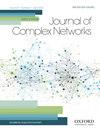Neuronal motifs reveal backbone structure and influential neurons of neural network in C. elegans
IF 1.5
4区 数学
Q2 MATHEMATICS, INTERDISCIPLINARY APPLICATIONS
引用次数: 0
Abstract
Neural network elements such as motif, backbone and influential nodes play important roles in neural network computation. Increasing researches have been applying complex network methods in order to identify different essential structures within complex neural networks. However, the distinct properties of synapses that build the neural network are often neglected, such as the difference between chemical synapses and electrical synapses. By separating these distinct synapses, we can identify a novel repertoire of neural motifs and greatly expand neural motif families in neural systems. Based on the expanded motif families, we further propose a novel neural-motif-based algorithm to extract the backbone in the neural network. The backbone circuit we extracted from Caenorhabditis elegans connectome controls an essential motor behaviour in C. elegans. Furthermore, we develop a novel neural-motif-based algorithm to identify influential neurons. Compared with the influential neurons identified using existing methods, the neurons identified in this work provide more information in related to their functions. These methods have been successfully applied to identify a series of network features in C. elegans, providing a biologically interpretable way of exploring the structure of neural network.神经元基序揭示了秀丽隐杆线虫神经网络的骨干结构和有影响的神经元
基序、骨干和影响节点等神经网络元素在神经网络计算中起着重要作用。越来越多的研究应用复杂网络方法来识别复杂神经网络中不同的基本结构。然而,构建神经网络的突触的独特特性经常被忽视,比如化学突触和电突触之间的区别。通过分离这些不同的突触,我们可以识别出新的神经基序,并大大扩展神经系统中的神经基序家族。在扩展基序家族的基础上,我们进一步提出了一种新的基于神经基序的神经网络主干提取算法。我们从秀丽隐杆线虫的连接组中提取的主干电路控制秀丽隐杆线虫的基本运动行为。此外,我们开发了一种新的基于神经图案的算法来识别有影响的神经元。与使用现有方法识别的有影响的神经元相比,本研究中识别的神经元提供了更多与其功能相关的信息。这些方法已成功地应用于线虫的一系列网络特征的识别,为探索神经网络的结构提供了一种生物学上可解释的方法。
本文章由计算机程序翻译,如有差异,请以英文原文为准。
求助全文
约1分钟内获得全文
求助全文
来源期刊

Journal of complex networks
MATHEMATICS, INTERDISCIPLINARY APPLICATIONS-
CiteScore
4.20
自引率
9.50%
发文量
40
期刊介绍:
Journal of Complex Networks publishes original articles and reviews with a significant contribution to the analysis and understanding of complex networks and its applications in diverse fields. Complex networks are loosely defined as networks with nontrivial topology and dynamics, which appear as the skeletons of complex systems in the real-world. The journal covers everything from the basic mathematical, physical and computational principles needed for studying complex networks to their applications leading to predictive models in molecular, biological, ecological, informational, engineering, social, technological and other systems. It includes, but is not limited to, the following topics: - Mathematical and numerical analysis of networks - Network theory and computer sciences - Structural analysis of networks - Dynamics on networks - Physical models on networks - Networks and epidemiology - Social, socio-economic and political networks - Ecological networks - Technological and infrastructural networks - Brain and tissue networks - Biological and molecular networks - Spatial networks - Techno-social networks i.e. online social networks, social networking sites, social media - Other applications of networks - Evolving networks - Multilayer networks - Game theory on networks - Biomedicine related networks - Animal social networks - Climate networks - Cognitive, language and informational network
 求助内容:
求助内容: 应助结果提醒方式:
应助结果提醒方式:


